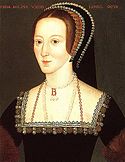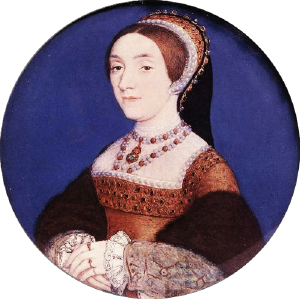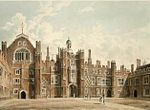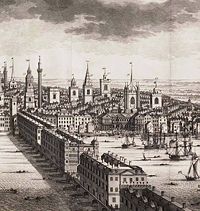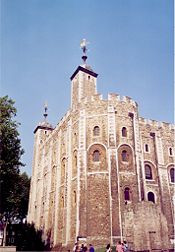Catherine Howard
| Catherine Howard | ||
|---|---|---|
| Queen Consort of England | ||
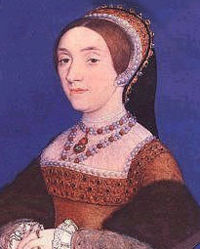
| ||
| Portrait miniature of Catherine Howard, by Hans Holbein the Younger. The manner of dress and jewelery suggest the subject's identity as Catherine. | ||
| Born | between 1520 and 1525 | |
| Died | 13 February 1542 | |
| Consort | July 28, 1540 – February 13, 1542 | |
| Consort to | Henry VIII | |
| Father | Lord Edmund Howard | |
| Mother | Joyce Culpeper | |
Catherine Howard (between 1520 and 1525 – February 13, 1542), also called Katherine or Kathryn[1] was the fifth wife of Henry VIII of England (1540-1542). She is sometimes known by his reference to her as "the rose without a thorn." Her birth date and place of birth is unknown but is occasionally cited as 1521, probably in London. She was the daughter of Lord Edmund Howard, a poor younger son of the 2nd Duke of Norfolk. She was also first cousin to Anne Boleyn, Henry's ill-fated second queen.
Catherine married Henry VIII on July 28, 1540, at Oatlands Palace in Surrey, almost immediately after his annulment from Anne of Cleves was arranged. However, Catherine's marital conduct and past history were eventually alleged to be unchaste, and she was beheaded after less than two years of marriage on the grounds of treason.
Biography
Early life
Catherine Howard was the tenth child of Lord Edmund Howard and Joyce Culpeper. Catherine's exact date of birth is unknown, although the year has been estimated as being between 1520 and 1525. She was the niece of the Duke of Norfolk, and a first cousin to Henry's second wife, Queen Anne Boleyn, and her sister Mary Boleyn.
The Howard family is sometimes called England's "second family." They are headed by the Duke of Norfolk, the "Premier Peer of the Realm." While legendary pedigrees trace the family to the tenth century, indisputable descent begins with Sir William Howard (died 1308), a judge in the House of Commons in the Model Parliament of 1295. The Howard family was known for its strong adherence to Roman Catholicism throughout the English Reformation and its aftermath. This meant that they often could not take their seats in the House of Lords. They are still known as the most prominent English Catholic family.[2]
Catherine's family, therefore, had an aristocratic pedigree. But her father, a younger son, was not well-off and often required handouts from his more powerful relatives. His niece, Anne Boleyn, obtained a government job for him working for the king in Calais in 1531.[3]
At this point, young Catherine was sent to live with her step-grandmother, Agnes Tilney, the Dowager Duchess of Norfolk. The duchess ran a large household at Lambeth Palace, and she had numerous attendants, along with her many wards, who were usually children of relatives who could not afford to support their families in the proper tradition of the nobility. Supervision was lax, as the duchess was often at Court and took little interest in the upbringing and education of her wards.
Consequently, Catherine was the least educated of Henry's wives, although she could indeed read and write, unlike many English women of her time. Her character is often described as merry and vivacious, but never scholarly or devout. The casual upbringing in the probably morally lax atmosphere of the duchess's household apparently led to a romance with her music teacher, Henry Mannox, around 1536, when Catherine was between the ages of 11 and 15. When she became queen, Mannox was appointed as a musician in her household and later gave evidence in the inquiry against her.
Mannox and Catherine both confessed during her trial that they had engaged in sexual foreplay: "At the flattering and fair persuasions of Mannox, being but a young girl, I suffered him at sundry times to handle and touch the secret parts of my body," she said. "And I do also admit that I enjoyed his relationship with me; though I shall never regret loving him, I do now love Henry."
This affair came to an end in 1538, when Catherine was wooed by a secretary of the duchess' household, Francis Dereham. They became lovers, reportedly even addressing each other as "husband" and "wife." Dereham also entrusted Catherine with wifely duties such as keeping his money when he was away on business. Many of Catherine's roommates knew of the affair, which was apparently ended in 1539 when the duchess caught wind of the matter. Despite this, Catherine and Dereham may have parted with intentions to marry upon his return from Ireland.
| The Six Wives of King Henry VIII |
|---|
Arrival at court
Eventually, Catherine's uncle found her a place at the court of Henry VIII. As a young and attractive lady-in-waiting to Henry's new German wife, Queen Anne of Cleves, Catherine quickly caught the attention of the King, who had never developed an attraction to his new queen.
Her relatives privately doubted that the young woman was mature enough to handle the responsibilities of being the king's mistress, as she had just arrived at court a few months earlier, but other factors were also at play. The memory of their relative Anne Boleyn's death for supposed adultery marred the standing of the Norfolks, a family proud of their grand lineage, in Henry VIII's court. The strongly Catholic family looked to Catherine as a figurehead both to restore their own prestige and in terms of their mission to restore the Catholic faith to England. As the king's interest in their relative grew, so did their influence. Within months of her arrival at court, Henry bestowed gifts of land and expensive cloth upon Catherine, and her status as the king's mistress, though unofficial, was clear.
Marriage
When Henry had his marriage to Anne of Cleaves annulled on July 9, 1540, rumors swirled that Catherine was already pregnant with his child. Their quick marriage just a few weeks after the divorce from Anne in 1540 also reflected Henry's lifelong urgency to secure the Tudor succession by begetting healthy sons. Catherine was probably 19 years old, and Henry, nearing 50 and expanding in girth, showered his young bride with wealth, jewels, and other expensive gifts. War with France and the Reformation had cost Henry the goodwill of many of his people, and he was then suffering from a number of ailments. The presence of the young and seemingly virtuous Catherine in his life brought him great happiness. Her motto, "No other wish (will) but his," reflects her queenly desire to keep Henry, a man 30 years her senior, content.
Unlike her cousin Anne Boleyn, Catherine was not much interested in politics or religion. However, in the spring of 1541 she sought to help two prisoners held in the Tower of London. Margaret Pole, Countess of Salisbury, was an elderly noblewoman of Plantagenet stock with a possible claim to the throne. She had been imprisoned for nearly two years and suffered the harsh winters without warm clothing. With Henry's permission, Catherine sent her some warm clothes, which she purchased with her own monies.
She also bravely asked Henry to pardon a former admirer of Anne Boleyn, the poet Sir Thomas Wyatt. Wyatt had been imprisoned for his association with the king's former secretary, Thomas Cromwell, who had been executed for his role in organizing the failed marriage of Anne of Cleaves to the king. Henry pardoned Wyatt, at Catherine's request, and then insisted that Wyatt reunite with his own estranged and unfaithful wife.[4]
Liaisons at court
However, despite her newly-acquired wealth and power, Catherine found her marital relations unappealing. It turned out that she was not pregnant upon marriage, and became repulsed by her husband's body. He weighed 300 pounds at the time and had an ill-smelling festering ulcer on his thigh that had to be drained daily.
Early in 1541, she embarked upon a romance with Henry's favorite male courtier, Thomas Culpeper, whom she reportedly desired when she came to court two years before. Their meetings were arranged by one of Catherine's older ladies-in-waiting, Lady Rochford, the widow of Anne and Mary Boleyn's brother, George Boleyn, who had testified against her husband and Anne.
Meanwhile, Henry and Catherine toured England together in the summer of 1541, and preparations for any signs of pregnancy (which would lead to Catherine's coronation as queen) were in place, thus indicating that the married couple were indeed sexually active. As Catherine's extramarital liaison progressed, people who had witnessed her indiscretions at Lambeth Palace began to contact her for favors. In order to buy their silence, she appointed many of them to her household. Most disastrously, she appointed Henry Mannox as one of her musicians and Francis Dereham as her personal secretary, both being former lovers of hers. This led to Catherine's charge of treason and adultery two years after the king married her.
Downfall
By late 1541, the "northern progress" of Henry and Catherine had ended, and Catherine's indiscretions rapidly became known thanks to John Lascelles, a Protestant reformer whose sister, Mary Hall, had witnessed Catherine's youthful liaisons. Motivated by the growing threat to the Protestant cause from conservative Catholicism, represented by Catherine's family, Lascelles presented the information to Thomas Cranmer, then Archbishop of Canterbury and a close adviser of Henry.
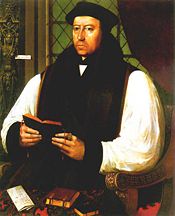
Cranmer, aware that any "pre-contract" with Dereham would invalidate Catherine's marriage to Henry, gave the king a letter with the accusations against Catherine on November 2, 1541. Henry at first refused to believe the allegations, thinking the letter was a forgery, and requested Cranmer further investigate the matter. Within a few days, corroborative proof was found, including the confessions issued from Dereham and Culpeper after they were tortured in the Tower of London, as well as a love letter written distinctively in Catherine's handwriting to Culpeper:
...praying you to send me word how that you do, for I never longed so much for a thing as I do to see you and to speak with you...
Yours as long as life endures,
Katheryn[5]
Catherine was charged with treason, but never, even to her confessor just hours before her death, admitted to betraying the king with Culpeper, though she readily admitted her behavior prior to her marriage was inappropriate.
Catherine was arrested on November 12, 1541. According to legend, she escaped her guards' clutches briefly to run to the church where Henry was taking mass. She banged on the doors and screamed Henry's name.
Eventually she was arrested by the guards and was taken to her rooms in Hampton Court, where she was confined, accompanied only by Lady Rochford. Her pleas to see Henry were ignored, and Cranmer interrogated her regarding the charges. Even the staunch Cranmer found Catherine's frantic, incoherent state pitiable, saying, "I found her in such lamentation and heavyness as I never saw no creature, so that it would have pitied any man's heart to have looked upon her."[6] He ordered the guards to remove any objects that she might use to commit suicide.
While the supposed pre-contract between Catherine and Dereham would have the unfortunate effect of terminating Catherine's royal marriage, it also would have allowed Henry to annul their marriage and banish her from court. Catherine would be disgraced, impoverished, and exiled, but ultimately spared the grisly fate of Anne Boleyn. However, she steadfastly denied any pre-contract, stating that Dereham forced himself upon her.
Imprisonment and death
Catherine was stripped of her title as queen on November 22 and imprisoned in Syon House, Middlesex, through the winter of 1541. Thomas Culpeper and Francis Dereham were executed at Tyburn on December 10, 1541—the former beheaded, the latter hanged, drawn and quartered—for treasonous conduct.[7] As was customary, their heads were placed atop London Bridge.
Catherine's relatives were also detained in the Tower, except her uncle Thomas, the Duke of Norfolk, who had sufficiently detached himself from the scandal. All of the Howard prisoners were tried, found guilty of concealing treason, and sentenced to life imprisonment and forfeiture of goods. However, in time they were released with their goods restored. Her maid, Jane Boleyn, Duchess of Rochford, was beheaded, after going insane, for her part in arranging the affair of Catherine and Thomas Culpeper.
Catherine's fate remained unresolved until Parliament passed a bill of attainder on January 21, 1542, that made the intent to commit treason punishable by death. This solved the matter of Catherine's supposed pre-contract and made her unequivocally guilty, since adultery by a queen was treason. She was taken to the Tower of London on February 10, 1542. On February 11, Henry signed the bill of attainder into law, and Catherine's execution was scheduled for 7 a.m. on February 13.
The night before her execution, Catherine is said to have spent many hours practicing how to lay her head upon the executioner's block. She died with relative composure, but looked pale and terrified, requiring assistance to climb the scaffold. Her speech spoke of "worthy and just punishment" asked for mercy for her family and prayers for her soul. According to unconfirmed popular folklore, her last words were, "I die a Queen, but I would rather have died the wife of Culpeper."[8] She was beheaded with one stroke, and her body was buried in an unmarked grave in the nearby Chapel of St Peter ad Vincula, where her cousin, Anne Boleyn, also lay.
Legacy
Catherine's body was one of those identified during restorations of the Chapel of St Peter ad Vincula in the reign of Queen Victoria and she is commemorated on a plaque on the west wall dedicated to those who died in the Tower.
Francis I of France wrote a letter to Henry upon news of Catherine's death, regretting the "lewd and naughty behavior of the Queen" and advising him that "the lightness of women cannot bend the honor of men."
Victorian writer Agnes Strickland argued that Catherine had been innocent of all charges laid against her. Others, such as American historian Lacey Baldwin Smith, described her life as one of "hedonism" and Catherine as a "juvenile delinquent." Alison Weir, in her 1991 book The Six Wives of Henry VIII, described her as "an empty-headed wanton."
Other biographers are more sympathetic—particularly David Starkey, who offered revolutionary theories on Catherine's adultery. Feminist activist Karen Lindsey, whose book Divorced, Beheaded, Survived: A Feminist Reinterpretation of the Wives of Henry VIII (1995) provided a sympathetic but realistic assessment of Catherine's character.
Notes
- ↑ There are several different spellings of "Catherine" that were in use during the sixteenth century and by historians today. Her one surviving signature spells her name "Katheryn" but such a spelling is no longer used. Her chief biographer, Lacey Baldwin Smith, uses the common modern spelling "Catherine"; other historians, for example Antonia Fraser, use the traditional English spelling of "Katherine".
- ↑ Memorials of the Howard Family (privately printed, 1834); and Lodge, Portraits of Illustrious Personages (London, 1835); "The Howard Papers, with a Biographical Pedigree and Criticism by Canston," Harding and Lepard publ. 1835, ASIN B000MZ8IKM
- ↑ "Biography of Katherine Howard" www.geocities.com. Retrieved May 13, 2008.
- ↑ Six Wives of Henry VIII www.pbs.org. Retrieved May 13, 2008.
- ↑ Catherine Howard, "In her own words" www.pbs.org. Retrieved May 13, 2008.
- ↑ Eleanor Herman, Sex with the Queen, pp. 81-82.
- ↑ 1541, The Fall of Catherine Howard englishhistory.net. Retrieved May 12, 2008.
- ↑ In her own words: "Letter of Queen Catherine Howard to Thomas Culpeper Spring 1541" www.pbs.com. Retrieved May 20, 2008.
ReferencesISBN links support NWE through referral fees
- Denny, Joanna. Katherine Howard: A Tudor Conspiracy. Piatkus Books; New edition, 2008. ISBN 978-0749951207
- Herman, Eleanor. Sex with the Queen. William Morrow, 2006. ISBN 0-06-084673-9
- Lindsey, Karen. Divorced, Beheaded, Survived: Feminist Reinterpretation of the Wives of Henry VIII. Da Capo Press, 1992. ISBN 0-201-40823-6
- Smith, Jessica. Katherine Howard. Ballantine Books, 1972. ISBN 9780345206480
- Smith, Lacey Baldwin. A Tudor tragedy: The life and times of Catherine Howard. J. Cape, 1962. ASIN B0007IWY3Q
- Starkey, David. Six Wives: The Queens of Henry VIII. Harper Perennial, 2004. ISBN 978-0060005504
- Strong, Roy: Artists of the Tudor Court: The Portrait Miniature Rediscovered 1520-1620. Victoria & Albert Museum exhibit catalog, 1983. ISBN 0905209346
- Weir, Alison. The Six Wives of Henry VIII. 1993. ISBN 0-8021-3683-4
External links
All links retrieved November 3, 2023.
- A brief overview of Catherine's life, accompanied by a portrait gallery tudorhistory.org
- Catherine Howard: Facts, Biography, Portraits & Information englishhistory.net
- PBS "Six Wives of Henry VIII," describing Catherine's death www.pbs.org
| English royalty | ||
|---|---|---|
| Preceded by: Anne of Cleves |
Queen Consort of England 28 July 1540 – 13 February 1542 |
Succeeded by: Catherine Parr |
George, Duke of Cumberland (1702-1707) · Mary of Modena (1685-1688) · Catherine of Braganza (1662-1685) · Henrietta Maria of France (1625-1649) · Anne of Denmark (1603-1619) · Philip II of Spain (1554-1558) · Lord Guildford Dudley (1553) · Catherine Parr (1543-1547) · Catherine Howard (1540-1542) · Anne of Cleves (1540) · Jane Seymour (1536-1537) · Anne Boleyn (1533-1536) · Catherine of Aragon (1509-1533) · Elizabeth of York (1486-1503) · Anne Neville (1483-1485) · Elizabeth Woodville (1464-1483) · Margaret of Anjou (1445-1471) · Catherine of Valois (1420-1422) · Joanna of Navarre (1403-1413) · Isabella of Valois (1396-1399) · Anne of Bohemia (1383-1394) · Philippa of Hainault (1328-1369) · Isabella of France (1308-1327) · Marguerite of France (1299-1307) · Eleanor of Castile (1272-1290) · Eleanor of Provence (1236-1272) · Isabella of Angoulême (1200-1216) · Berengaria of Navarre (1191-1199) · Eleanor of Aquitaine (1154-1189) · Matilda of Boulogne (1135-1152) · Geoffrey V, Count of Anjou (1141) · Adeliza of Louvain (1121-1135) · Matilda of Scotland (1100-1118) · Matilda of Flanders (1066-1083)
Credits
New World Encyclopedia writers and editors rewrote and completed the Wikipedia article in accordance with New World Encyclopedia standards. This article abides by terms of the Creative Commons CC-by-sa 3.0 License (CC-by-sa), which may be used and disseminated with proper attribution. Credit is due under the terms of this license that can reference both the New World Encyclopedia contributors and the selfless volunteer contributors of the Wikimedia Foundation. To cite this article click here for a list of acceptable citing formats.The history of earlier contributions by wikipedians is accessible to researchers here:
The history of this article since it was imported to New World Encyclopedia:
Note: Some restrictions may apply to use of individual images which are separately licensed.
